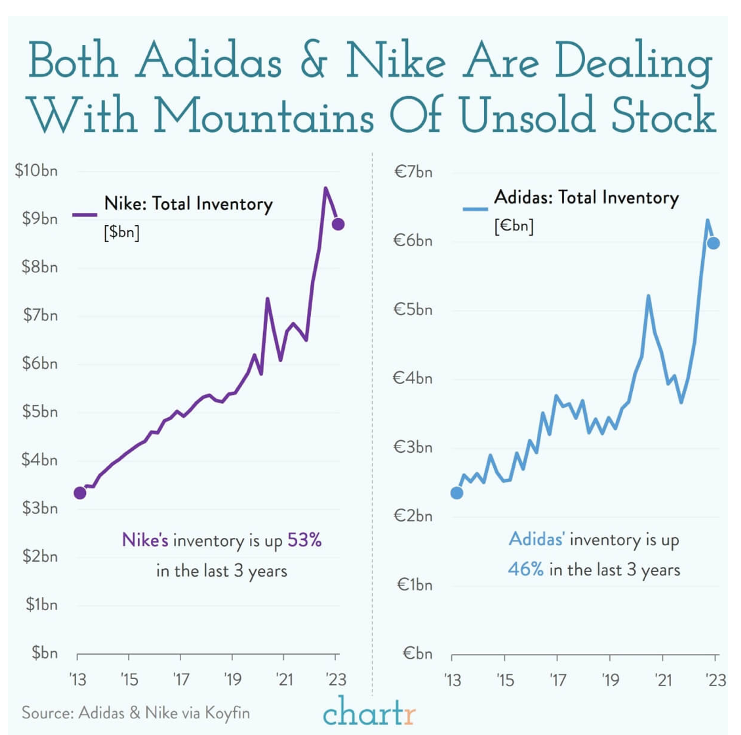Winning the Inventory Game with AI-Powered Demand Planning

The COVID-19 pandemic wreaked havoc on supply chains, leaving manufacturers and retailers scrambling to keep products available on shelves. In today’s post-pandemic world, the challenge has shifted to preventing an excess of stock (also known as inventory glut) as the longstanding problem of aligning supply with consumer demand returns. We believe that to manage inventory effectively, businesses need to lean into AI-powered demand planning. AI-powered demand planning makes it possible for businesses to adapt to market changes, forecast demand, and optimize inventory levels accordingly. With AI's ability to analyze big data from various sources, companies can make informed decisions and keep the right products at the right levels in the right locations.
In this article, we'll take a closer look at inventory glut and explore some recent examples of how it has affected major retailers like Nike, Adidas, Target, and Walmart -- and how AI-driven forecasting can be the game changer.
Everything Must Go
Nike and Adidas are two of the world's largest sports apparel and footwear companies, and both have been grappling with inventory glut in recent years. In Q4 2022, Nike reported 11% decline in net income due to excess inventory, which the company attributed to supply chain disruptions and changes in consumer behavior during the pandemic. The apparel giant had a 14% increase in sales, reaching $12.3 billion n in Q4 2022, but still has a near-record high inventory level, which has increased by 53% in the last 3 years. Nike executives are hopeful to get inventory back to healthy levels by the end of the financial year, but their main competitor in the sportswear industry is not as optimistic.
Adidas also reported excess inventory in 2022, with CEO Kasper Rorsted stating that the company had been too optimistic in its demand forecasting. Worst case scenario, Adidas may have 2023 as its first annual loss in 30 years due to inventory issues. To address the issue, Adidas announced plans to reduce its global store count by 30% over the next few years, focusing instead on e-commerce and digital sales channels.
Target and Walmart are two of the largest retailers in the world, and both have also been affected by inventory glut in recent years. In 2023, Target reported an 87% hit to operating profit due to excess inventory, a result of misjudging demand and prioritizing product quantity over price. Similarly, Walmart has also faced challenges with excess inventory, with CEO Doug McMillon acknowledging in a recent earnings call that the company had too much inventory in some categories.
To address the issue, both retailers have been working to optimize its supply chain, improve demand forecasting, and its inventory management systems. With the impact on consumers from inflation in mind, continuing additional markdowns and canceling orders are the best hope to remove excess inventory while not adding extra burden on stores and supply chain teams for managing the excess inventory in the system.

Image source: chartr
Everyday Low Price
Target and Walmart are two of the largest retailers in the world, and both have also been affected by inventory glut in recent years. In 2023, Target reported an 87% hit to operating profit due to excess inventory, a result of misjudging demand and prioritizing product quantity over price. Similarly, Walmart has also faced challenges with excess inventory, with CEO Doug McMillon acknowledging in a recent earnings call that the company had too much inventory in some categories.
To address the issue, both retailers have been working to optimize its supply chain, improve demand forecasting, and its inventory management systems. With the impact on consumers from inflation in mind, continuing additional markdowns and canceling orders are the best hope to remove excess inventory while not adding extra burden on stores and supply chain teams for managing the excess inventory in the system.
AI-Powered Demand Planning
The case studies of Nikes, Adidas, Target, and Walmart reinforce the reality that excessive inventory is costly. What can manufacturers and retailers do to address and avoid repeating the problem of inventory glut? The answer lies in demand planning that incorporates AI.
Demand planning entails forecasting and managing customer demand for products. It helps businesses better understand the needs of their customers, optimize inventory levels, reduce stockouts or overstocks, improve customer service, and maximize profitability. Demand planning involves steps ranging from data collection to performance measurement.
AI can improve demand planning by making it possible for manufacturers and retailers to better understand consumer demand from one store to the next and align demand with supply. Trained with quality data and complemented with real-time data from third-party sources including search trends, social media content, and weather data, AI unearths patterns of behavior more effectively than any human being can. Indeed, McKinsey study shows that businesses can reduce errors by between 20% and 50% by incorporating AI in demand planning.
For instance, search trends offer real-time insights that anticipate consumer demand. According to Google, in 2020, as people went into lockdown mode during the pandemic, Google noticed an uptick in searches for “candle-making kits” (a 300-percent increase). Searches for “patio heaters” increased by 600 percent as people moved to eating outdoors. Google regularly publishes search trends for a variety of categories. AI models can track this data, synthesize it, and recommend changes to demand forecasting as a result.
L’Oréal, a French multinational and one of the world’s largest beauty products manufacturers, has used information from various sources to anticipate trends, optimize sales and predict customer demand. L’Oréal uses sources such as social media, weather, and financial market indicators – along with data gathered at point-of-sales, such as collection, reception, and inventory – as a starting point. From there, L’Oréal can target customers more effectively and respond to the challenge of demand volatility.
How Centific Can Help
The right resource can help reduce waste. That’s why we created Meerkat.
Meerkat is an all-in-one demand, pricing, and promotions planning platform from Centific that gives users the ability to deliver the right product, at the right moment, at the right price while simultaneously delivering financial value for your stakeholders.
Meerkat leverages state-of-the-art, pre-trained AI models that are fueled by your own company data, alongside a broad range from our extensive data partner ecosystem, to solve challenges such as forecasting and demand planning, pricing, and promotion planning.
Our solution allows organizations to jumpstart better decision-making by seamlessly integrating with existing enterprise platforms. Not only does this allow you to leverage and maximize ROI on past investments, but you are also able to scale rapidly, regardless of your organization's readiness level.
Want to reduce waste and innovate? Contact us.
For Further Reading
“Memorial Day, Hot Dogs, and The Forecasting Conundrum”
“How to Boost Your Profits, Save the Planet, and Learn to Love AI”
“How AI Can Help Retailers and CPG Firms Create Magic Moments on Easter”
